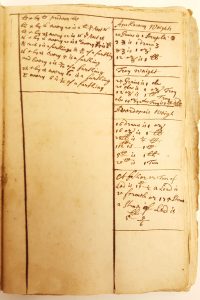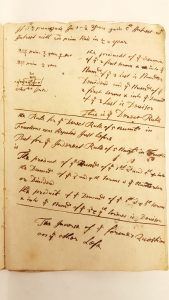Four Math Problems and a Question
![(Fig. 1) Question 32: “In the rectangle Triangle ABC is given the base AB=9 and the difference of the other sides that is the segment BD=3. Required the sides AC and BC severaly[sic].” Question 33: “In the Rectangle Triangle ABC is given the base AB=5 and the sum of the other sides AC+BC=25. Required the sides AC·BC ¬¬¬severaly[sic].” The Cabell Family Papers, Series 2, Box 11, Msv#15.](https://libraries.wm.edu/sites/default/files/images/scrc-archive/2016/09/CabellArithmetic_01-576x1024.jpg)
The Cabell Family Papers, Series 2, Box 11, Msv#15.
Interspersed among the survey notes of Dr. William Cabell (1699-1774) within the Cabell Family Papers, 1693-1913, are mathematical problems ranging from standard arithmetic to algebraic equations. The majority of the inscriptions are in an unknown hand, possibly one of Dr. Cabell’s children, but we cannot be certain.
The earliest notebook containing these mathematical problems dates to 1745. The calculations made equate to problems found in a contemporary Algebra I or geometry class (Fig.1), albeit not all the solutions are correct (Fig. 2).
![(Fig. 2) Question 13: “There is an army to which if you add ½[,] ⅓[,] ¾ of itself and take away 5000 the sum total will be 100000[.] What was the Nº of the army[?]” The Cabell Family Papers, Series 2, Box 11, Msv#15.](https://libraries.wm.edu/sites/default/files/images/scrc-archive/2016/09/CabellArithmetic_02-576x1024.jpg)
The Cabell Family Papers, Series 2, Box 11, Msv#15.
The practice, use, and understanding of plane geometry and trigonometry function beyond the balancing of account books. For Dr. W. Cabell, it was occupationally necessary; in fact, geometric measurements and calculations appear regularly throughout his field notes and land surveys.. He served as assistant surveyor in Goochland and Albemarle Counties in Virginia from 1730, working under Joshua Fry and William Mayo; meanwhile, his son, Col. William Cabell, Sr., and grandson, William Cabell, Jr., followed in this footsteps, being appointed surveyors of Albemarle County and Amherst County.

In addition, Dr. W. Cabell was a practicing surgeon who would have had to contend with three different eighteenth century systems of mass and weight, including apothecary, troy, and avoirdupois (Fig. 3). The majority of these symbols we recognize today, like the apothecary pound ℔ or scruple ℈i. Other more literal symbols like □a is replaced by the more contemporary a². Yet, not all of these symbols are easily identifiable.
![(Fig. 4) Merchant arithmetic problem by Nicholas Cabell. “If 800 __ in ½ a year gains 20 __ what Time[sic] will 66‒⅔ gain 5 ¬¬[?]" The Cabell Family Papers, Series 2, Box 10, Msv#16.](https://libraries.wm.edu/sites/default/files/images/scrc-archive/2016/09/CabellArithmetic_04-e1474403864877-197x300.jpg)
“If 800 __ in ½ a year gains 20 __ what Time[sic] will 66‒⅔ gain 5 ¬¬[?]"
The Cabell Family Papers, Series 2, Box 10, Msv#16.
One set of merchant arithmetic problems have been identified as Nicholas Cabell’s, Dr. William’s youngest son (1750-1803) who fought in the Amherst County militia during the Revolution and was an elected state senator from 1786-1801. The notebook dates between 1750-1779. While we cannot discount Nicholas’s potential as a mathematical child prodigy, his birth in 1750 adds some certainty that this set of problems were done at earliest in the late 1750s--sometime during Nicholas’s youth--as Dr. William’s accounts recorded annual payment for the schooling of his three sons. The word problems that filled Nicholas’s notebook dealt largely with monetary exchange and business transactions, nothing that a few algebraic equations could not solve (Fig. 4)

The Cabell Family Papers, Series 2, Box 10, Msv#16.
What is most interesting are the symbols Nicholas uses. Some symbols function as contractions or abbreviations, which is one of the reasons that reading old manuscripts can be difficult. In Nicholas’s proof explanation of the Rule of [Three] Direct, the abbreviated “yͤ” substituted “the” (Fig. 5). Harder to  decipher is a particular symbol placed above certain numerical values that consistently appear without any corresponding meaning discernible from either the measurement chart or handwriting comparison. Does it denote £ symbol or other increments of currency? If any reader recognizes this marking or can offer some clarity to this ongoing question, please contact Special Collections! In the meantime, try your hand at a few of these problems to see how you might fair against eighteenth-century mathematics. Did your answers or process differ from the steps and solutions provided? More importantly, how much of high school algebra do you actually remember? Cabell Family Papers, 1693-1913
decipher is a particular symbol placed above certain numerical values that consistently appear without any corresponding meaning discernible from either the measurement chart or handwriting comparison. Does it denote £ symbol or other increments of currency? If any reader recognizes this marking or can offer some clarity to this ongoing question, please contact Special Collections! In the meantime, try your hand at a few of these problems to see how you might fair against eighteenth-century mathematics. Did your answers or process differ from the steps and solutions provided? More importantly, how much of high school algebra do you actually remember? Cabell Family Papers, 1693-1913

